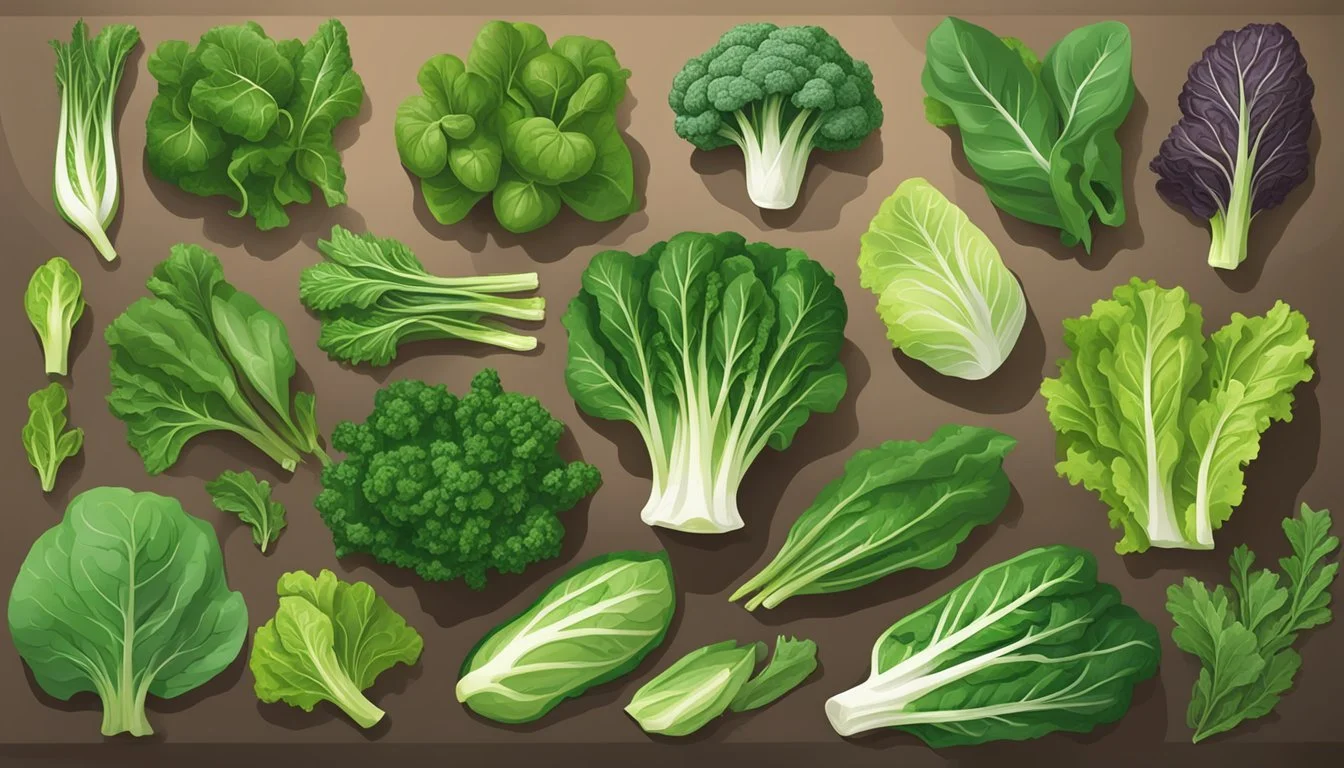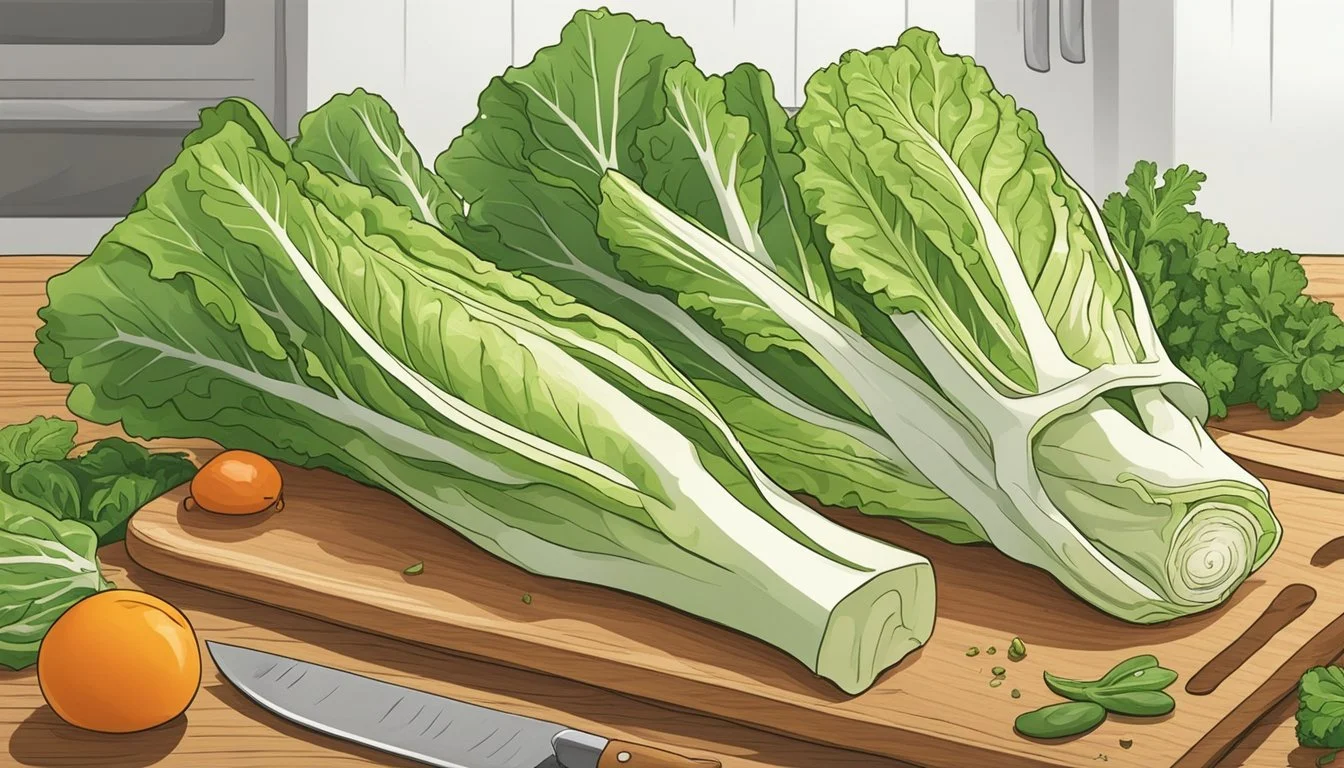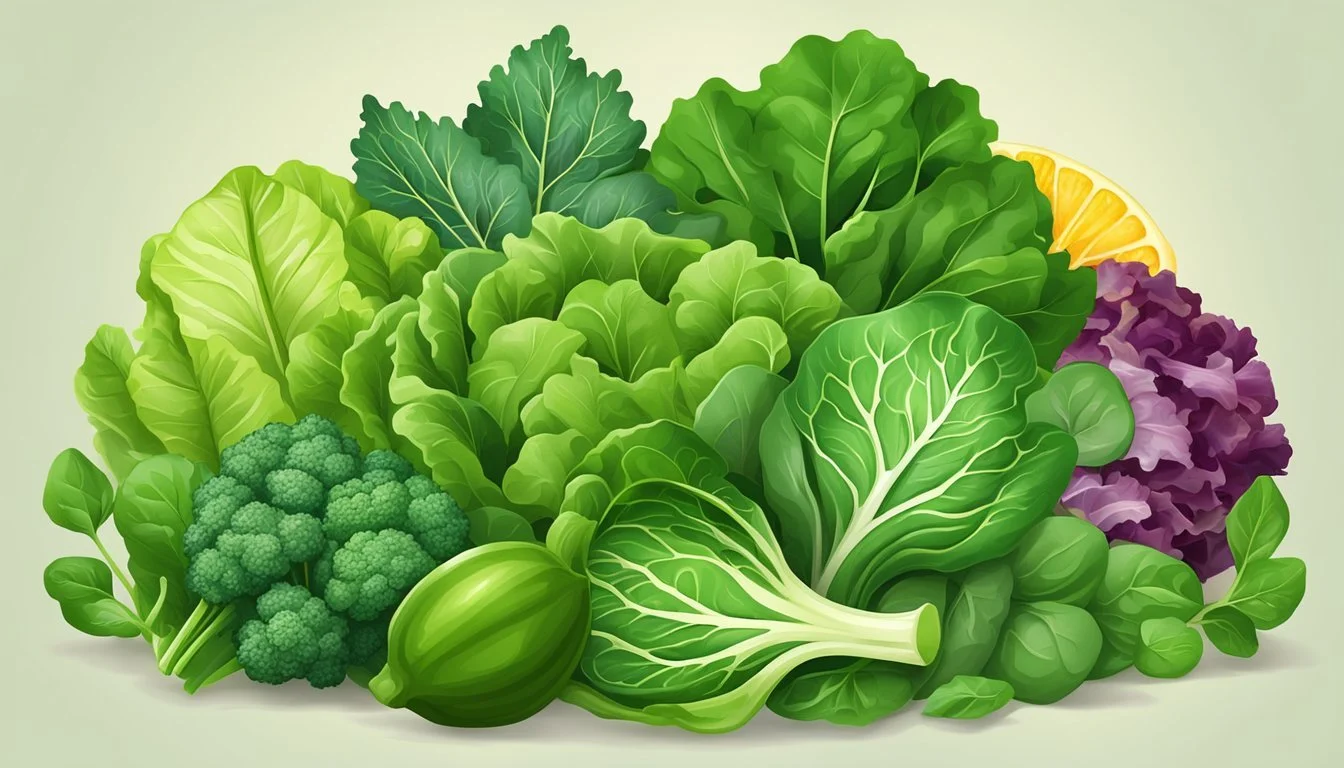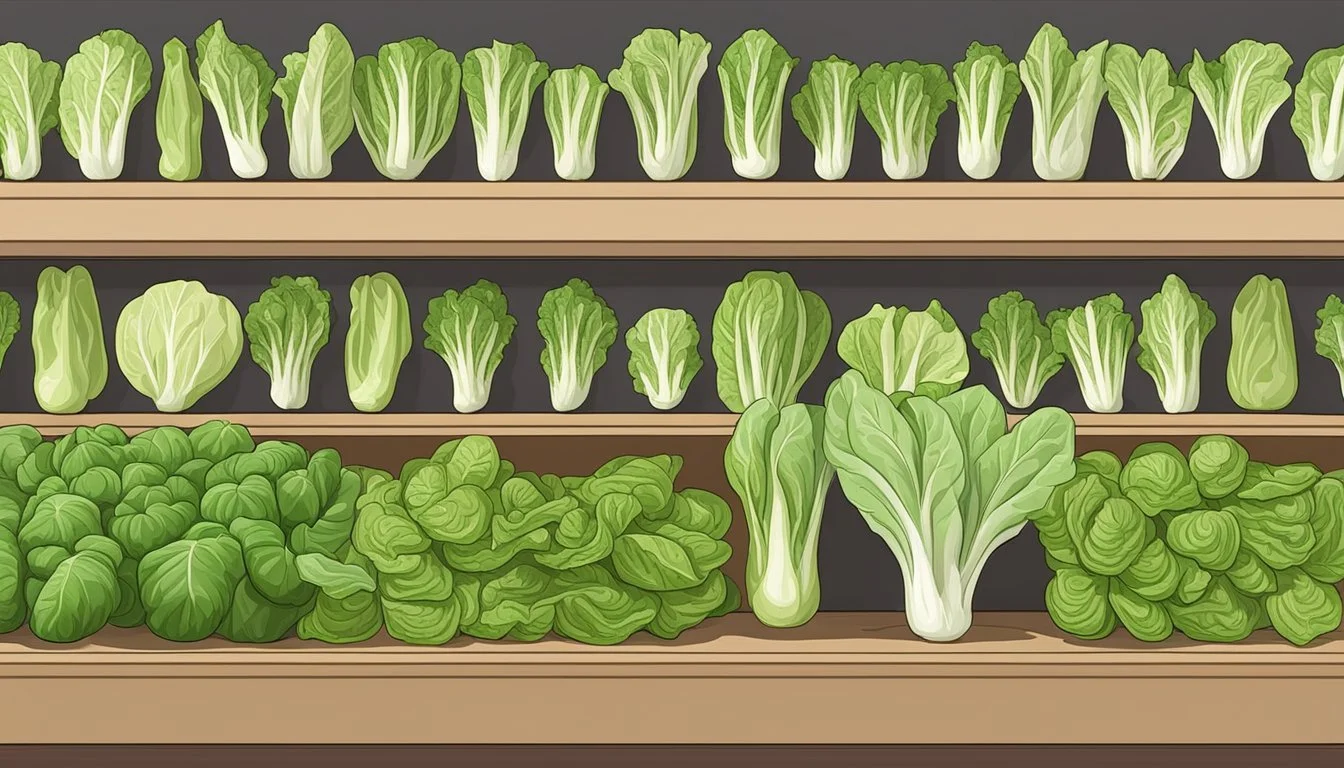Romaine Lettuce Substitutes
Top Alternatives for Your Salads
When it comes to finding substitutes for Romaine lettuce, there are numerous alternatives that can offer a similar crunch and flavor. Whether for salads, sandwiches, or other dishes, these substitutes can ensure you never miss Romaine. Radicchio, with its bitter and tangy flavor, serves as a crisp and vibrant option.
Leafy greens such as kale and spinach are also excellent substitutes, each bringing unique nutritional benefits and textures. For a milder taste, Boston lettuce or iceberg lettuce can be used. These options not only diversify your meals but provide a solution in situations when Romaine is unavailable or unsuitable.
From chicory-like endives to the sturdy bok choy, there is no shortage of choices to replace Romaine in your recipes. Embrace these alternatives to keep your dishes exciting and nutritious.
Health Benefits of Romaine Lettuce
Romaine lettuce offers numerous health benefits, thanks to its rich nutritional profile. It is packed with essential vitamins, minerals, and fiber that support diet and weight management and boost the immune system.
Nutritional Profile
Romaine lettuce is a low-calorie food, with only about 8 calories per cup. It provides a significant amount of dietary fiber, which aids in digestion.
Nutrient Content per Cup:
Calories: 8
Protein: 0.58 g
Carbohydrate: 1.5 g
Fiber: 1 g
The lettuce is also low in fat, making it an ideal choice for those looking to maintain a healthy diet.
Vitamins and Minerals
Romaine lettuce is a powerhouse of essential vitamins and minerals. One cup of romaine supplies over 50% of the daily requirement for vitamin A, primarily from beta-carotene. This vitamin is crucial for vision and skin health.
Key Vitamins and Minerals:
Vitamin A: Important for eye health and skin.
Vitamin K: Helps in blood clotting and bone health.
Vitamin C: Acts as an antioxidant and boosts the immune system.
Folate: Essential for DNA synthesis and repair.
Iron: Critical for the formation of red blood cells.
The presence of potassium helps maintain healthy blood pressure levels. Calcium and magnesium found in romaine are also vital for bone health.
Diet and Weight Management
Incorporating romaine lettuce into the diet aids in weight management. Its low calorie and high fiber content make it filling without adding extra calories.
The high water content also helps in keeping one hydrated while providing bulk to the diet. This leafy green can be a part of salads, sandwiches, or wraps, contributing to a balanced, nutrient-dense meal.
Improvement of Immune System
Romaine lettuce boosts the immune system due to its rich content of vitamins A and C. These vitamins function as antioxidants, neutralizing free radicals in the body.
The fiber content not only aids digestion but also supports gut health, which is closely linked to immunity. Regular consumption can help reduce inflammation and improve the body's defense against illnesses and infections.
Romaine Lettuce in Cuisine
Romaine lettuce plays a versatile role in many dishes, adding texture and flavor. Its unique characteristics are highlighted in salads, wraps, sandwiches, garnishes, appetizers, and even as a pizza topping.
Salad Preparation
Romaine lettuce's crisp texture makes it a staple in many salad recipes. The iconic Caesar salad often features chopped romaine leaves, which provide a crunchy base. Romaine can be paired with a variety of ingredients such as croutons, parmesan cheese, and different dressings. It's common to see romaine combined with grilled chicken, bacon bits, and avocados for a hearty, nutritious meal.
Wraps and Sandwiches
In wraps and sandwiches, romaine lettuce serves as an excellent layer for added crunch and freshness. Whether it's a chicken wrap or a turkey sandwich, a few romaine leaves can enhance the dish. Romaine leaves can also be used as a low-carb alternative to bread, perfect for lettuce wraps filled with grilled meats, hummus, and vegetables. The texture remains firm, holding the ingredients together well.
Garnishes and Appetizers
Romaine lettuce leaves can be used as elegant garnishes for a variety of dishes. Smaller leaves are often used to decorate platters or as a base for appetizers like stuffed leaves. Popular appetizer recipes include romaine "boats" filled with mixtures of seafood, cheese, or seasoned meats. Romaine's slightly bitter edge can complement various flavors, making it an ideal choice.
Pizza Toppings
While less traditional, romaine lettuce can be used as a topping for pizzas, particularly those featuring a lighter, fresher profile. After baking, fresh romaine leaves can be scattered atop a finished pizza along with ingredients like cherry tomatoes, olives, and feta cheese. The addition of romaine can provide a refreshing crunch that contrasts well with melted cheese and cooked toppings.
Common Romaine Lettuce Substitutes
Various substitutes can successfully replace romaine lettuce, offering similar textures, flavors, and nutritional benefits. The alternatives below are categorized into leafy greens, crunchy variants, and herbaceous and peppery options.
Leafy Green Substitutes
Spinach, kale, and collard greens are popular leafy greens that can substitute for romaine lettuce. Spinach provides a softer texture and a slightly sweet flavor, making it suitable for salads and sandwiches. Kale is more robust, offering a stronger, sometimes bitter taste, but it holds up well in hearty salads and cooked dishes. Collard greens, though tougher, bring a slightly bitter profile and work well in cooked recipes where romaine would typically be used.
Examples:
Spinach: Soft texture, slightly sweet.
Kale: Stronger flavor, more robust.
Collard Greens: Slightly bitter, tougher leaves.
Crunchy Lettuce Variants
For those who prefer the crispiness of romaine, iceberg lettuce, butterhead lettuce, and loose leaf lettuce are excellent choices. Iceberg lettuce is known for its crunchy texture and mild flavor, making it ideal for salads and sandwiches. Butterhead lettuce, which includes both Bibb and Boston varieties, offers a tender texture with a sweet, buttery flavor. Loose leaf lettuce provides a balance of crunch and tenderness, and it comes in various colors and flavors.
Examples:
Iceberg Lettuce: Crunchy texture, mild flavor.
Butterhead Lettuce (Bibb/Boston): Tender, sweet, buttery.
Loose Leaf Lettuce: Mix of crunch and tenderness, varied flavors.
Herbaceous and Peppery Alternatives
Several greens offer a peppery or herbaceous flavor profile that can substitute for romaine in different dishes. Arugula, with its distinctive peppery taste, adds a unique twist to salads and sandwiches. Watercress brings a peppery and slightly bitter flavor, suitable for fresh salads and garnishes. Radicchio and endive, both members of the chicory family, impart a bitter flavor that complements rich and savory dishes.
Examples:
Arugula: Peppery, distinctive.
Watercress: Peppery and slightly bitter.
Radicchio: Bitter, crisp texture.
Endive: Bitter, pairs well with rich flavors.
Flavor Profiles and Textures
Different substitutes for romaine lettuce bring unique flavors and textures to the table. Each variety can impact the overall taste and experience of a dish, whether you are looking for a bitter twist or a mild, buttery softness.
Suitable for Bitterness
Radicchio stands out for its bitter, tangy flavor and crisp texture. This leafy vegetable belongs to the chicory family and can be a bold alternative for romaine. While its bitterness adds depth, it's vital to balance it with milder components in the salad.
Other suitable substitutes with a slightly bitter flavor include dandelion greens and endive. These options offer complexity in taste and a crisp bite that pairs well with many dressings and ingredients.
Crunch Factor in Substitutes
For those who enjoy the crunch that romaine provides, iceberg lettuce is an excellent option. Known for its firm and crunchy texture, iceberg is ideal for salads, snacks, and sandwiches where crispness is desired. While it may lack some of the nutrients found in romaine, its texture makes up for this shortfall.
Spinach and kale are other alternatives that, while not as crunchy as iceberg, still offer a satisfying bite. Incorporate these greens if you're looking for a crisp component without sacrificing too many nutrients.
Varieties with Buttery and Mild Taste
Butter lettuce, also known as Boston or Bibb lettuce, offers a very different experience. Its soft, buttery leaves provide a mild taste that complements a variety of dishes. Unlike the crunch of romaine, butter lettuce brings a delicate texture which can be ideal in more gentle-flavored salads.
Spinach provides another mild-tasting option, though with a slightly firmer texture compared to butter lettuce. Its smooth leaves can work well in many recipes where a softer green is preferable.
In summary, choosing the right substitute for romaine lettuce can greatly affect the flavor and texture of your dish. Whether you are looking for bitterness, crunch, or a buttery mild taste, there are plenty of alternatives that can meet your needs effectively.
Nutritional Considerations for Substitutes
When choosing substitutes for Romaine lettuce, it's important to consider the nutritional profile of each alternative. These include differences in nutrient content, dietary fiber levels, and calorie counts.
Differences in Nutrients
Different greens offer various nutrients that can complement or even surpass those found in Romaine lettuce. Radicchio, for instance, boasts high levels of vitamin K and antioxidants. Butterhead lettuce provides a mild, sweet taste and is rich in vitamin A and vitamin C. Spinach is another excellent substitute, known for its high iron and protein content. These differences highlight the importance of selecting substitutes based on specific nutritional needs.
Dietary Fiber Content
Dietary fiber is essential for digestive health, and the substitutes for Romaine lettuce vary in their fiber content. Kale and arugula are known for their higher fiber concentrations compared to traditional Romaine. Endives and escarole also provide significant fiber, contributing to a feeling of fullness and aiding digestion. Monitoring fiber intake when switching greens can help maintain a balanced diet.
Low-Calorie Options
Several Romaine lettuce substitutes offer low-calorie ways to enjoy leafy greens. Iceberg lettuce, while lower in nutrients compared to some options, is very low in calories. Bok choy and Chinese lettuce are also low-calorie choices that provide a crisp texture and mild flavor. These options allow for volume and variety without significantly increasing daily caloric intake.
Switching from Romaine to other greens can enhance a meal’s nutritional profile, ensuring that the diet remains rich in essential vitamins and minerals while also catering to specific dietary needs such as low-calorie or high-fiber requirements.
Selecting Substitutes Based on Recipes
Choosing the right substitute for romaine lettuce depends on the dish you are preparing. The alternatives vary in texture, flavor, and nutritional content, so select a replacement that complements your recipe.
Alternatives for Salads
When making salads, consider substitutes with both a similar crunch and a pleasant flavor. Arugula offers a peppery taste that works well in bold salads. Spinach provides a softer texture but adds a wealth of nutrients such as iron. For a bit of bitterness, Radicchio can bring a unique profile, though its flavor may need balancing with sweeter ingredients. Butterhead lettuce is another option, offering a mild taste and tender leaves.
Options for Cooked Dishes
For dishes that require cooking, robust greens like kale and Swiss chard are excellent choices. They hold up well to heat without becoming soggy. Collard greens are another strong leafy vegetable that can be used in soups and stews. Bok choy adds a slight crunch and mild flavor, making it suitable for stir-fries. Escarole can also be utilized in cooked dishes, providing a subtle bitterness that mellows when cooked.
Substitutes for Crunch in Snacks
Snacks requiring a crunchy element benefit from leafy greens with firm textures. Iceberg lettuce is a straightforward replacement, offering a similar crispness to romaine. Cabbage, particularly Napa cabbage, brings an excellent snap and a slightly sweet taste. Endives provide both crunch and a slight bitterness, enhancing the flavor profile of wraps or toppings. For a bit of spice, kale chips are a crunchy alternative that can be seasoned to taste before baking.
Safety and Risks of Lettuce Varieties
Understanding the safety and risks associated with lettuce varieties is essential for maintaining health and preventing foodborne illnesses. Various lettuce types have had different historical contamination events, and knowing prevention and awareness steps can help minimize risks.
Historical Contamination Events
Lettuce, especially romaine, has frequently been associated with E. coli outbreaks. The Centers for Disease Control and Prevention (CDC) often issues warnings about romaine due to multiple contamination events. For example, a major outbreak in 2018 linked to romaine lettuce sickened 238 people across the United States. Similarly, another outbreak in 2024 saw a rise in cases affecting several states.
Romaine lettuce is not the only variety at risk. Other leafy greens like spinach and mixed salad greens have also been implicated in contamination events. These outbreaks often originate from contaminated water sources used during irrigation. Understanding these historical events highlights the importance of safety measures in the food supply chain.
Prevention and Awareness
Preventing contamination starts with proper handling and awareness. Washing greens under running water can reduce surface bacteria. Some recommend using a diluted vinegar solution for added safety; however, this may not fully eliminate harmful pathogens. Consumers should also stay updated on current CDC advisories about contaminated produce.
For safer consumption, individuals can consider growing their own lettuce or purchasing from local organic farms since smaller supply chains might pose fewer risks. Regular inspection of lettuce leaves for any signs of spoilage, such as wilting or discoloration, is also crucial. Awareness and proactive measures can significantly curb the risks associated with consuming various lettuce varieties.
Storage and Shelf Life
Proper storage of romaine lettuce is essential to maintaining its freshness and prolonging its shelf life. Effective techniques can help prevent wilting and spoilage, ensuring that the lettuce remains crisp and tasty.
Preserving Freshness
To keep romaine lettuce fresh, start by washing and drying the leaves thoroughly. Wrap the leaves in a dry paper towel and place them in a resealable plastic bag, pressing out as much air as possible before sealing. Store the bag in the refrigerator's crisper drawer.
Alternatively, you can store the leaves in a large container, such as a mason jar or bowl, filled with water to submerge the lettuce completely. Cover and refrigerate, changing the water every one to three days to prevent bacterial growth. Both methods help keep the lettuce hydrated, which is key to maintaining its crispness.
Buying pre-packaged romaine hearts is another convenient option. These often come sealed in plastic bags and should be stored in the coldest part of the refrigerator. Whether using individual leaves or hearts, keeping them in a cold, humid environment will extend their shelf life.
Signs of Wilting and Spoilage
Wilting and spoilage are primary concerns when storing romaine lettuce. Look for signs such as leaves turning yellow or brown, slimy textures, or an off smell. These are indicators that the lettuce is no longer fresh.
Touch is an important tool for assessing lettuce quality. Crisp, firm leaves suggest freshness, while limp and soft leaves indicate wilting. Visually inspect for any dark spots or mold growth, which are clear signs of spoilage.
Frequently check stored romaine lettuce and promptly remove any leaves that show signs of deterioration. This helps prevent the spread of spoilage to healthy leaves. Proper vigilance and timely intervention can significantly extend the shelf life of romaine lettuce.
Environmental Impact of Lettuce Cultivation
Lettuce cultivation impacts the environment through water usage, greenhouse gas emissions, and resource inputs. Key methods and practices influence these impacts substantially.
Sustainable Farming Practices
Sustainable farming practices in lettuce cultivation aim to minimize environmental harm. Techniques such as crop rotation and intercropping improve soil health and reduce the need for chemical fertilizers. Precision irrigation helps in conserving water by delivering it directly to the plant roots.
Controlled Environment Agriculture (CEA) systems like hydroponics use less water compared to traditional farming. This method also reduces land use, as lettuce can be grown vertically in stacked systems. Sustainable energy sources, such as solar panels, further lower the carbon footprint of these systems.
Organic Versus Conventional Growth
Organic lettuce cultivation avoids synthetic pesticides and fertilizers, relying on natural amendments like compost. This method helps in maintaining soil integrity and biodiversity. Organic farms often use integrated pest management (IPM) practices to control pests without harmful chemicals.
On the other hand, conventional farming methods may offer higher yields but often do so at the cost of greater chemical inputs and potential soil degradation. These methods can lead to runoff that contaminates waterways. Choosing organic over conventional can significantly reduce the overall environmental footprint of lettuce production.









